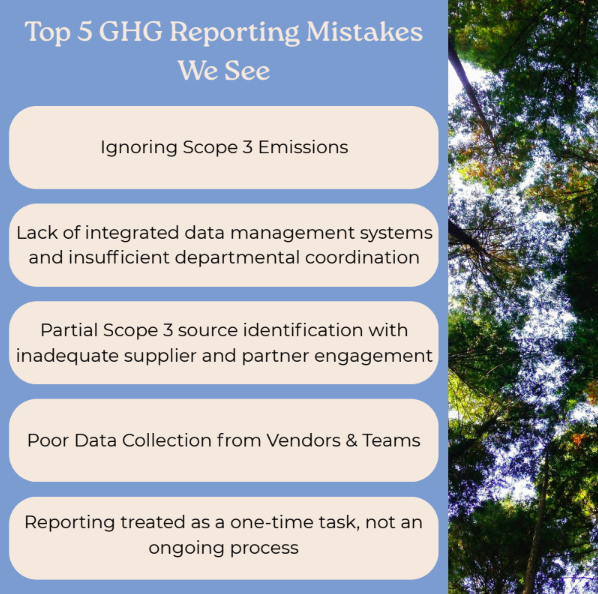Top 5 GHG Reporting Mistakes to Avoid in 2025
Why Accuracy in GHG Reporting Matters More Than Ever
As global climate disclosure regulations get sharper from the EU’s CSRD to India’s BRSR Core and SEC’s upcoming climate rules greenhouse gas (GHG) reporting is under the spotlight. Companies are expected not only to disclose emissions, but also to prove that their data is credible, complete, and actionable. Yet many well-intentioned companies make simple, avoidable mistakes that reduce trust, miss insights, or even risk non-compliance. In this guide, we explore the top 5 GHG reporting mistakes to avoid in 2025 and how to get it right with the help of robust frameworks and tools like those offered by Planetary Plus.

- Ignoring Scope 3 Emissions
What happens: You’ve calculated your Scope 1 and 2 emissions (like fuel and electricity), but skipped Scope 3 those hard-to-track emissions in your value chain.
Why it matters: Scope 3 often makes up 70-90% of a company’s carbon footprint. Ignoring them paints an incomplete picture and limits your impact strategy.
Fix it: Map your value chain emissions categories (from purchased goods to business travel), Start with available data and use estimation methods when needed, Use a Scope 3 tool (like Planetary Plus) that auto-calculates emissions based on procurement data.
- Using Outdated or Inconsistent Emission Factors
What happens: You use an old Excel sheet with outdated emission factors, or apply country-average data when more accurate sources are available.
Why it matters: Emission factors directly impact your reported footprint. Inaccurate factors lead to incorrect totals—potentially damaging credibility or skewing performance metrics.
Fix it: Use up-to-date factors from recognized sources (e.g. IPCC, EPA, DEFRA, India GHG Platform), Apply region-specific and activity-specific factors whenever possible, Automate factor updates using GHG accounting platforms like Planetary Plus.
- Not Setting Clear Boundaries
What happens: You’re unsure if emissions from contractors or foreign subsidiaries should be included, or you mix up product-level and organizational boundaries.
Why it matters: Ambiguity leads to underreporting or double-counting, making audits and stakeholder reviews difficult.
Fix it: Clearly define both organizational boundaries (control vs. equity share) and operational boundaries (Scope 1, 2, 3), Follow GHG Protocol or ISO 14064 guidance, Document all boundary decisions for transparency.
- Lack of Data Quality Checks or Third-Party Validation
What happens: You rely on rough estimates or unverified spreadsheets without internal review or assurance.
Why it matters: Data inconsistencies undermine ESG reports, delay assurance processes, and weaken investor confidence.
Fix it: Run regular internal audits to check data sources, calculations, and assumptions,Invest in third-party validation (especially for public disclosures),Use dashboards that flag anomalies in real time.
- Reporting Without Action
What happens: You report your GHG numbers every year, but don’t connect them to reduction targets or decarbonization strategies.
Why it matters: Stakeholders today expect impact, not just information. Reporting without action leads to greenwashing perceptions or missed performance gains.
Fix it: Use emissions data to set Science-Based Targets or net-zero roadmaps,Identify emission hotspots and link them to operational improvements, Communicate progress transparently in reports and dashboards.
2025-Ready GHG Reporting: 3 Key Tips
- Align reports with global frameworks like CDP, BRSR, CSRD, and TCFD.
- Automate reporting workflows to reduce manual errors.
- Train internal teams on GHG basics, scope categories, and software use.
No Matter Where You Are on Your GHG Journey — We’re Here to Guide You
Whether you’re a beginner or a seasoned ESG leader, Planetary Plus offers end-to-end support for your GHG journey. Ready to take the next step? Let’s build a low-carbon future together — one footprint at a time.
